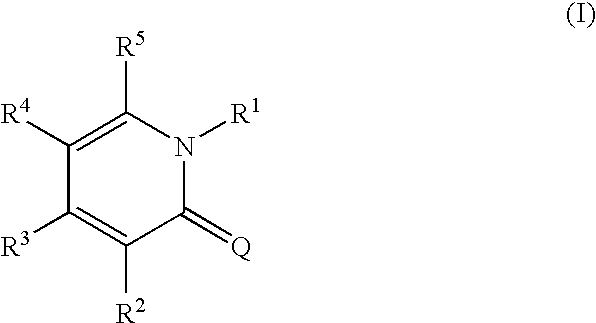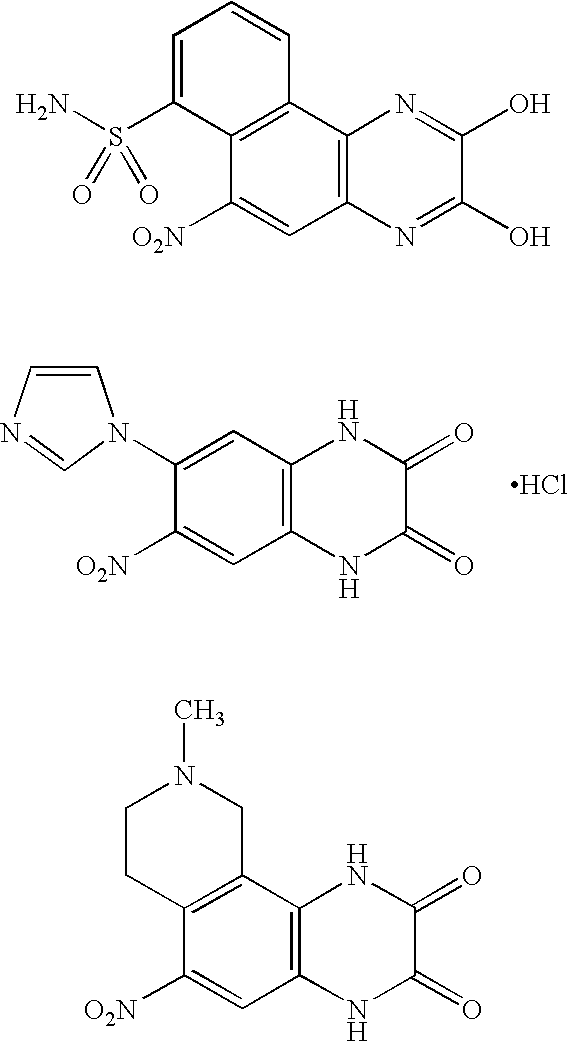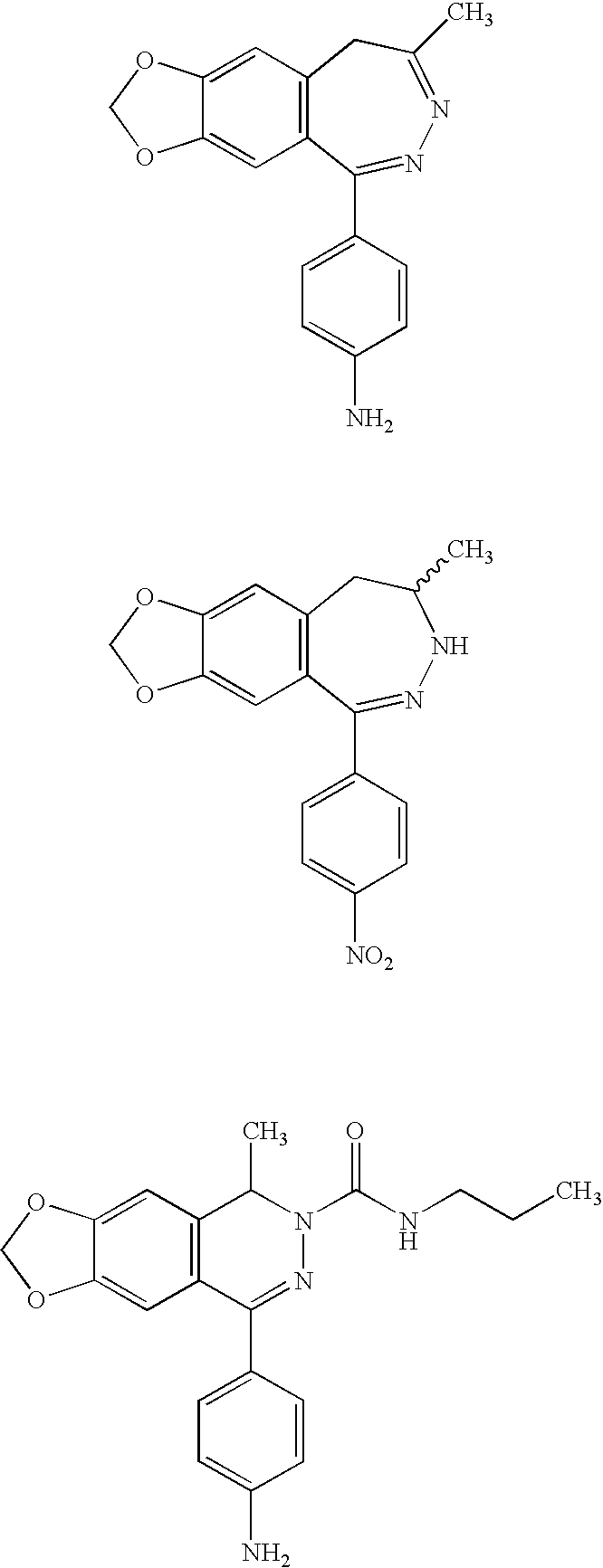1, 2-Dihydropyridine compounds, manufacturing method thereof and use thereof
a technology of dihydropyridine and dihydropyridine, which is applied in the field of pyridone, can solve the problems of said toxicity as serious, and achieve the effect of excellent method of production and excellent antagonistic action to ampa receptors
- Summary
- Abstract
- Description
- Claims
- Application Information
AI Technical Summary
Benefits of technology
Problems solved by technology
Method used
Image
Examples
referential example 1
5-Bromo-3-iodo-1,2-dihydropyridin-2-one
[0071]
[0072] 2-Amino-5-bromopyridine (CAS No. 1072-97-5) (300 g) was dissolved in a mixed solvent consisting of 1000 ml of acetic acid and 200 ml of water, 30 ml of concentrated sulfuric acid were gradually dropped thereinto under stirring. Then, 79.1 g of periodic acid hydrate and 176 g of iodine were added thereto, followed by stirring at 80° C. for 4 hours. To the reaction mixture were added periodic acid hydrate (40 g) and iodine (22 g), followed by further stirring at 80° C. for 2 hours. After cooling to room temperature, the reaction mixture was poured onto ice (3000 ml) and neutralized to pH 7.0 with 5N aqueous sodium hydroxide. The resulting crystals were collected by filtration, dissolved in a mixed solvent of ethyl acetate / diethyl ether, successively washed with aqueous sodium thiosulfate, water, 1N aqueous sodium hydroxide and brine, and dried over anhydrous magnesium sulfate. Then, the solvent was evaporated, to give 392 g of 2-ami...
referential example 2
5-Bromo-1-phenyl-3-iodo-1,2-dihydropyridin-2-one
[0074]
[0075] 5-Bromo-3-iodo-1,2-dihydropyridin-2-one (10.0 g) obtained in Referential Example 1, 10.0 g of phenylboronic acid and 8.1 g of copper acetate were suspended in 500 ml of dichloromethane. 15 ml of triethylamine were added thereto, followed by stirring at room temperature for 5 days and nights. To the reaction solution were added 200 ml of water and 50 ml of aqueous ammonia, followed by stirring vigorously. Then the insoluble matters were filtered off through Celite, the filtrate was extracted with dichloromethane, the extract was dried over anhydrous magnesium sulfate. The solvent was evaporated, and the residue was recrystallized from ethyl acetate / hexane, to give 6.54 g (yield: 52%) of the title compound.
[0076]1H-NMR (400 MHz, CDCl3); δ (ppm) 7.34-7.38 (m, 2H), 7.44-7.52 (m, 3H), 7.53 (d, 1H), 8.10 (d, 1H).
referential example 3
5-Bromo-3-(2-cyanophenyl)-1-phenyl-1,2-dihydropyridin-2-one
[0077]
[0078] 5-Bromo-1-phenyl-3-iodo-1,2-dihydropyridin-2-one (11.69 g) obtained in Referential Example 2, 8.0 g of 2-(2-cyanophenyl)-1,3,2-dioxaborinate and 16.0 g of cesium carbonate were suspended in 150 ml of dimethylformamide. 3.0 g of tetrakistriphenylphosphine palladium were added thereto, followed by stirring at 80° C. in nitrogen atmosphere for 2 hours. The reaction solution was poured into water, the mixture was extracted with ethyl acetate, the extract was successively washed with water and brine and dried over anhydrous magnesium sulfate. Then, the solvent was evaporated, and the residue was purified by a silica gel column chromatography (hexane / ethyl acetate system), followed by recrystallizing from ethyl acetate / hexane, to give 5.67 g (yield: 52%) of the title compound.
[0079]1H-NMR (400 MHz, CDCl3); δ (ppm) 7.42-7.54 (m, 6H), 7.61-7.65 (m, 4H), 7.66 (d, 1H), 7.74-7.77 (m, 1H).
PUM
| Property | Measurement | Unit |
|---|---|---|
| temperature | aaaaa | aaaaa |
| temperature | aaaaa | aaaaa |
| pH | aaaaa | aaaaa |
Abstract
Description
Claims
Application Information
 Login to View More
Login to View More - R&D
- Intellectual Property
- Life Sciences
- Materials
- Tech Scout
- Unparalleled Data Quality
- Higher Quality Content
- 60% Fewer Hallucinations
Browse by: Latest US Patents, China's latest patents, Technical Efficacy Thesaurus, Application Domain, Technology Topic, Popular Technical Reports.
© 2025 PatSnap. All rights reserved.Legal|Privacy policy|Modern Slavery Act Transparency Statement|Sitemap|About US| Contact US: help@patsnap.com



